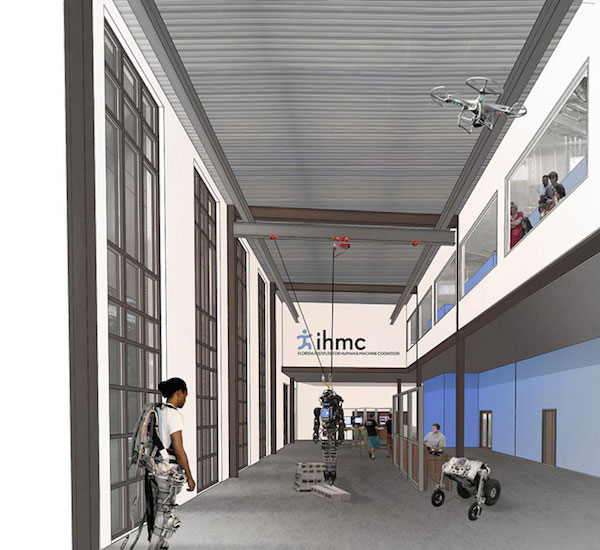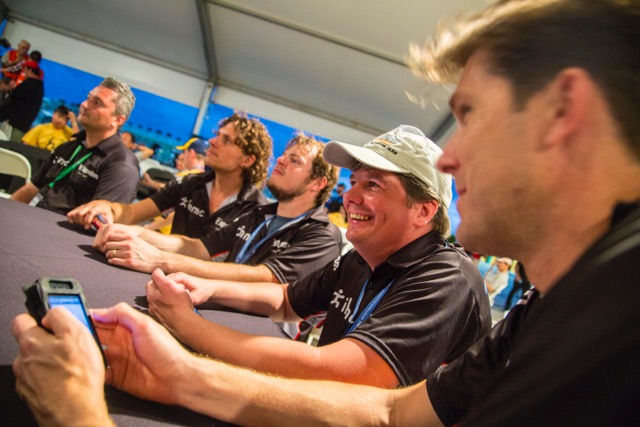Design proposals sought for new IHMC research center
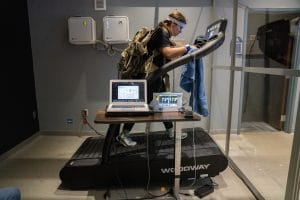
Human performance research at IHMC will find a new home in a planned facility slated to open in early 2024.
Published 1.28.22
A $20 million hub of research into human healthspan, resilience, and performance is moving closer to coming out of the ground.
The Florida Institute for Human and Machine Cognition has issued a Request for Qualifications for architectural, engineering and construction administration services. This RFQ can be found at https://www.ihmc.us/2022building/
Proposals are due Feb. 11. Once finalists are culled from the applications, presentations will be scheduled. A decision is expected by Feb. 28, 2022; construction is expected to begin later this year.
The new IHMC Healthspan, Resilience and Performance Research Complex will be a leading-edge lab and office building. The projected four-story 44,000 square foot facility will include space for administrative support, outreach and training, in addition to state-of-the-art laboratories for the scientific team.
It expands IHMC’s downtown campus to three primary buildings and dedicates a space for the center’s research into improving the resilience and performance of people.
Since IHMC’s founding in 1990, it has built an international reputation for excellence and innovation in robotics and artificial intelligence.
The HRP Center will extend that reputation for excellence in a new direction and reflects a strategic expansion of the vision of IHMC founder and CEO Ken Ford.
“IHMC’s international reputation in robotics and artificial intelligence speaks for itself,” Ford says. “Our Healthspan Resilience and Performance team will focus on innovative ways to extend the capabilities and resilience of high-performing humans such as astronauts, fighter pilots, and elite special operators.”
The HRP team’s work is focused on improving the performance of elite military members given the stressors they face. But the ultimate applications could be far-reaching, offering substantial healthspan benefits to the general population.
Dr. Marcas Bamman, the senior research scientist who leads the HRP team, sees the center’s work as something that covers “molecules to the whole human.”
“It’s more than applied science,” he says. “It’s seeing who performs a task well, unraveling the how and why, and taking what we learn to optimize ways of improving each person’s abilities.”
The goal is for the team to occupy the new building in January 2024.
IHMC is a not-for-profit research institute of the Florida University System where researchers pioneer science and technologies aimed at leveraging and extending human capabilities. For more information, visit ihmc.us.
Science Saturdays Return
Published 1.21.22
Science Saturday is back in business for 2022.

IHMC’s popular STEM outreach program hosted four sessions in the fall of 2021 for grade-schoolers in both Ocala and Pensacola. The free, monthly event featured increased safety measures in response to the pandemic and still brought students a lineup of hands-on projects geared toward sparking the love of science for students in grade 3-6.
The educational series is moving forward in 2022, says Ursula Schwuttke, director of educational outreach for IHMC, continuing its longstanding tenure as a community fixture that sees IHMC and community scientists lead half-day sessions that use “fun science” to spark learning, Schwuttke says.
“Fun science gives kids the ability to discover their interest and ability in science, and to develop self-confidence,” she says. “Opportunity is vitally important for kids. Without the opportunity to discover their interest, they can’t know that it’s something they should pursue.”
In fall of 2021, Science Saturday hosted sessions on computer game design, robotics, neural networks and machine learning, and the physics of roller coasters. Roughly 35-40 students attended each of these sessions. The Science Saturday lineup for 2022 includes sessions on game design, robotics, circuits, monarch butterflies and more.
Parents find Science Saturday provides much-needed science enrichment.
“The fact that this is the only enrichment Science opportunity in Ocala that is free and open to all of Marion County Public School students is extraordinary and greatly appreciated!” says the parent of a fourth-grade boy who attended in Ocala.
“My first child counts science and math as her favorite subjects. My second has a wonderful science curiosity and is open to all kinds of lessons, so I appreciate a wide diversity in your programming,” says a Pensacola parent. “Thanks for a consistently high quality experience in our children’s community.”
The adults at the head of the classes enjoy it, too, including Heath Parr, technology education teacher at Brown-Barge Middle School in Pensacola.
“I enjoy teaching Science Saturday’s because the hands-on activities allow the students to truly engage with the lessons,” Parr says. “The students are allowed to move, discuss, and interact with each other. These learning environments are important to independent inquiry and leads to deeper understanding and knowledge retention.”
For 2022, safety guidelines around masks, limiting occupancy, and distancing will be in place to help everyone stay safe while they learn. Enrollment will be capped at 24 students per session.
Sign-up for each session opens two weeks before the date of each Saturday. To register your child, email PensacolaScienceSat@ihmc.us or call 850-202-4462.
Visit www.ihmc.us/outreach/science_saturdays and join the mailing list to stay up to date.
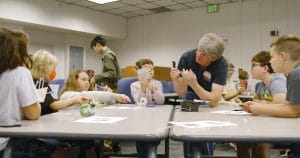

UWF and IHMC’s Intelligent Systems and Robotics program celebrate first Ph.D. graduate

Published 1.10.22
Taher Rahgooy, a Ph.D. candidate of the intelligent systems and robotics program launched by the Institute for Human and Machine Cognition and University of West Florida, became the program’s first graduate at UWF’s Fall Commencement in December 2021.
Rahgooy was among the initial cohort of five students to join the program when it was established two years ago and was one of two students who transferred to UWF from Tulane University on the heels of Dr. Brent Venable, the program’s founding director. Venable previously held a joint appointment as a professor of computer science at Tulane and research scientist at IHMC.
“The graduation of our first doctoral student is an incredible milestone for the intelligent systems and robotics program,” Venable said. “Only two years after its establishment, our program is contributing to the highly skilled workforce in the intelligent systems field, which is a national priority with a high demand market. His graduation validates and motivates all of our students, as well as UWF and IHMC mentors, to continue pursuing our innovative and personalized approach to graduate education in intelligent systems and robotics.”
Rahgooy was a second year doctoral student at Tulane University when Venable accepted the director role at UWF. He said it wasn’t initially an easy decision to transfer, but three key factors played a role in convincing him to make the jump.
“I really enjoyed working with Dr. Venable, as she is an extraordinary researcher and advisor and I knew that continuing to work with her would keep me on track for my future career,” Rahgooy said. “She told me about the IHMC community, which gives intelligent systems and robotics students access to world-class researchers. Finally, I knew the program would provide facilities for doctoral students that are essential for performing many machine learning and artificial intelligence tasks requiring the handling of big data.”
The program centers on developing leading-edge software and hardware technology that combines human and machine elements to exploit their respective strengths and mitigate their respective weaknesses. The first of its kind in Florida and one of only a few in the nation, the program serves the manufacturing, health care, defense and other high-tech industries, providing critical support to high-demand career fields.
The doctorate in intelligent systems and robotics program provides students with individualized paths tailored to their interests. The program includes foundational courses in robotics and artificial intelligence that address topics such as knowledge representation and reasoning, machine learning, computational methods in AI, basic hardware/software interaction and research methods.
“Through the program, I worked with great researchers who helped me understand the whole research environment better, and who gave help and guidance about the choices I should make for my future,” Rahgooy said. “The financial support of the program allowed me to fully focus on research without any distractions, and I was always supported and encouraged by the department to participate in prestigious conferences both for presenting my work and as an attendee. This accelerated my progress, which resulted in several publications and presentations.
“I feel really proud of what I’ve achieved and the kind of resume I was able to build in this program.”
Established in 2019, the program has grown to include 17 students from seven countries and 20 supervisors from IHMC and UWF’s departments of intelligent systems and robotics, computer science and earth and environmental sciences. Venable said the “cutting-edge” research portfolio of investigated topics includes human-machine teaming, vision, robotics, natural language processing, cybersecurity, machine learning, cognitive systems, multi-agent systems and marine environmental sensing.
“Our program allows the ‘mentor-student team’ to tailor the coursework and research portfolio to specific interests pursued by each team, following the European style for doctorates and freeing them from the academic constraints typically involved in the vast majority of AI and robotics graduate programs in the United States,” Venable said. “This level of personalization facilitates collaboration with industry and a project-driven style of research.”
Rahgooy earned a bachelor’s degree in computer engineering and a master’s in artificial intelligence before beginning his doctoral studies in computer science at Tulane University.
His dissertation, titled “Machine Learning Guided by Linguistic and Behavioral Knowledge,” discusses the data-driven methods he’s developed for learning various cognitive models of decision-making, along with his work to expand into problems with sequential settings such as reinforcement learning.
Rahgooy said the next step in his career is finding research positions in the intelligent systems and robotics industry to continue his efforts.
“Working with Taher has been a true pleasure,” Venable said. “He is the ideal doctoral student, one to whom you throw an idea and he comes back with a paper. He features a rare combination of a theoretical clarity of thought and very strong algorithmic and coding skills. He has grown into a mature and independent expert in intelligent systems and I am looking forward to hearing about his future successes.”
International leader in human performance accepts leadership role at IHMC
Published 5.7.21
 IHMCs Director and CEO Dr. Ken Ford announced that Dr. Morley O. Stone, the former senior vice president for research at the Ohio State University is joining the institute as Chief Strategic Partnership Officer.
IHMCs Director and CEO Dr. Ken Ford announced that Dr. Morley O. Stone, the former senior vice president for research at the Ohio State University is joining the institute as Chief Strategic Partnership Officer.
Dr. Stone is recognized as an international leader in human performance and biomimetics with nearly 30 years of experience in research and development. At IHMC, he will assume a leadership role in developing external strategic relationships with federal agencies, research universities and the private sector as well as implementing, coordinating and initiating scientific projects and assisting and mentoring IHMC scientists and research staff.
As senior vice president for research, Dr. Stone oversaw an annual budget of over $1billion in basic and applied research while at Ohio State. Prior to OSU, Morley served as the Chief Technology Officer for the Air Force Research Laboratory where he was responsible for assisting with the planning and execution of an annual $2.1 billion Air Force science and technology program and an additional $2.3 billion in externally funded research and development. From 2003 to 2006, Dr. Stone accepted an assignment as Program Manager in the Defense Sciences Office at the Defense Advanced Research Projects Agency (DARPA).
Dr. Stone earned his PhD in biochemistry from Carnegie Mellon University and his research interests are broad spanning areas such as the interface of materials science, biotechnology, human performance, and autonomous systems. In addition to his research leadership, Dr. Stone is a recognized leader in government and higher education in addressing and preventing foreign influence in research and development.
IHMC is a not-for-profit research institute of the Florida University System where researchers pioneer science and technology aimed at leveraging and extending human capabilities.
IHMC’s James Allen honored as one of nation’s top scientists
Published 11.24.20
IHMC Associate Director and Senior Research Scientist James Allen has been elected to the rank of AAAS Fellow by the American Association for the Advancement of Science.

University of Rochester computer science professor James Allen in the computer studies building July 08, 2011. //photo: J. Adam Fenster/University of Rochester
Each year the association elects members whose efforts to advance science and its applications are considered distinguished and scientifically valid. AAAS specifically cited Allen for his “broad contributions to artificial intelligence and natural-language understanding, including seminal contributions in temporal logic.”
In addition to his work at IHMC, which he joined in 2006, Allen also has an appointment as the John H. Dessauer Professor of Computer Science at the University of Rochester in Rochester, N.Y.
Since earning his Ph.D. in computer science in 1979 from the University of Toronto and receiving the Presidential Young Investigator award from the National Science Foundation in 1984, Allen has built an international reputation as a leader in AI and collaborative human-machine interaction.
“This is such a well-deserved honor for James,” said IHMC Chief Executive Officer Ken Ford. “Throughout his career, James has been an AI thought leader. I, as well as the rest of James’ colleagues here at IHMC, are extremely happy for him.”
The designation of AAAS Fellows began in 1874. James’ official election as a Fellow will be honored at the association’s annual meeting, which this year, because of COVID-19, will be held virtually in February.
IHMC is a not-for-profit research institute of the Florida University System where researchers pioneer technologies aimed at leveraging and extending human capabilities. For more information, visit ihmc.us.
IHMC podcast in the running for international award
Published 4.28.20
The International Academy of Digital Arts and Sciences announced this week that STEM-Talk has been nominated for the Webby Awards, an international competition recognizing internet excellence.
STEM-Talk, an educational service of the Florida Institute for Human and Machine Cognition (IHMC), received nominations in the science and education podcast categories for the Webby Awards as well as the Webby People’s Voice Awards. Academy members select winners for the Webby Awards while the People’s Voice Awards are voted on by the public.
People have until May 7th to visit vote.webbyawards.com to cast their ballots.
As a Webby nominee, STEM-Talk has been singled out as one of the five best podcasts in the world in the science and education category. Last year, more than three million people from 230 countries cast ballots in the People’s Voice awards.
STEM-Talk won first place the past two out three years in the science and medicine category of the Annual People’s Choice Podcast Awards.
Ken Ford, IHMC’s co-founder and CEO, co-hosts the podcast with IHMC Research Scientist Dawn Kernagis. STEM-Talk, with more than 100 episodes, features conversations with some of the most interesting people in the world of science and has been downloaded by more than two million people since its launch in 2016. For more information on IHMC, visit www.ihmc.us.
STEM-Talk wins People’s Choice award for second time in three years
Published 10.23.19
For the second time in its three years in existence, IHMC’s podcast STEM-Talk has won first place in the science and medicine category at the 14th Annual People’s Choice Podcast Awards.
The international competition features thousands of nominees in more than 20 categories. According to Todd Cochrane, who founded the competition in 2005, People’s Choice recognizes the top podcasts in the world as nominated by listeners.
“The awards are truly independent and the shows that are nominated and win have significant bragging rights as being listener favorites,” said Cochrane.
STEM-Talk is nearing its 100th episode and also closing in on 2 million downloads. In 2017, STEM-Talk not only took home the top prize in the science and medicine category, but also was runner-up for the competition’s grand prize.
STEM-Talk bills itself as “conversations with some of the most interesting people in the world of science and technology.” The guests have ranged from Nobel Prize winners in physics to NASA Astronauts to numerous thought leaders in the medical sciences.
The podcast uploads to iTunes, Stitcher, Google, Overcast and other podcast apps twice a month.
IHMC CEO Dr. Ken Ford co-hosts the podcast with IHMC Research Scientist Dr. Dawn Kernagis. Senior Creative and Multimedia Specialist William Howell edits the podcast along with staff member Jordan Accardo. Communications Director Randy Hammer is the show’s producer.
Some of STEM-Talk’s more popular episodes include:
- Dr. Stuart Phillips, professor of kinesiology at McMaster University, who in episode 82 talked about his research into muscle health and dietary protein.
- Dr. Robert Epstein, a psychologist, journalist and former editor of Psychology Today, who talked about his academic career in behavioral sciences in episode 89 and also his most recent research into the invisible influence that technology companies, particularly Google, have on consumer and political behavior.
- Megan Roberts, the scientific director at Nourish Balance Thrive, who was featured in episode 92 and is best known for her 2017 paper in Cell Metabolism that showed a ketogenic diet extended the longevity and health span of adult mice.
To find these episode and others, visit ihmc.us/stemtalk.
IHMC and Andrews Research and Education Foundation announce partnership to conduct research projects
Published 6.17.19
Pensacola’s cutting-edge research center The Florida Institute for Human & Machine Cognition (IHMC) and the Andrews Research & Education Foundation (AREF), the research arm of the Andrews Institute in Gulf Breeze, have signed an agreement to collaborate on human-performance research.
“We’re really fortunate to have two world leaders in human-performance right here in our community,” said Ken Ford, co-founder and CEO of IHMC. “This partnership is going to leverage the work of both organizations for the benefit of sports medicine as well as programs geared toward improving the capabilities and resilience of astronauts, fighter pilots, divers and other elite members of our military.”
IHMC and AREF will share office and lab space at their Pensacola and Gulf Breeze facilities. The scientists and doctors will collaborate on research into areas ranging from optimizing physical and cognitive performance to developing technologies aimed at helping high-performing humans like professional athletes, astronauts and fighter pilots.
“People here at AREF are thrilled they’ll be able to work with IHMC in areas that will help us with neurosurgery, neuroscience, ophthalmology and, of course, sports medicine,” said Ashton Hayward, president of Andrews Research & Education Foundation.
IHMC is a not-for-profit research institute that has grown into one of the world’s premier research organizations. Its scientists and engineers investigate a broad range of scientific and technological topics with the goal of amplifying and extending human cognition, perception, locomotion and resilience. In particular, IHMC has been a leader in AI, robotics, and human performance in extreme environments. The Pensacola-headquartered research institute is part of the Florida University System with a branch in Ocala.
AREF is the research arm of the Andrews Institute, the nation’s premier orthopaedics and sports medicine center. Andrews Institute is part of Baptist Health Care and was founded by Dr. James Andrews, an orthopaedic surgeon known for treating knee, elbow and shoulder injuries as well as repairing damaged ligaments. He has helped treat injuries and revive the careers of numerous high-profile athletes such as Drew Brees, Bo Jackson, Roger Clemens, Jerry Pate, Jack Nicklaus, Charles Barkley and Michael Jordan.
Hayward, who spent eight years as mayor of Pensacola before joining AREF in January, said the mission is to help educate the public and further research into the areas of orthopaedics, human performance, injury prevention, technology as well as surgical and biomedical enhancement.
“Most people are aware of the clinical work we do with athletes,” said Hayward. “But it’s not as well known that we also do a lot of work with active-duty members of the special- operations community. We provide them physical therapy, performance training and nutritional support.”
It was this work with the special-operations community that particularly drew the interest of IHMC Research Scientist Dawn Kernagis.
“As we have expanded our research into biological ways to extend the capabilities and resilience of high-performing humans in the military, especially those who have to operate in extreme conditions, a partnership with AREF made perfect sense,” said Dr. Kernagis, who leads a dozen members of IHMC’s bio-medical team.
Immediate plans include IHMC and AREF personnel working together on current ongoing research projects as well as developing proposals for future projects and grants.
For more information on AREF visit: https://www.andrewsref.org
The most important, innovative company to open in Ocala in the past 20 years.
The February 2019 issue of Ocala Style has named IHMC as the most important, innovative company to open in Ocala in the past 20 years. You can read the article here, https://issuu.com/ocalastyle/docs/0219os_book/32
UWF partners with IHMC to develop first intelligent systems and robotics Ph.D. in Florida
Published 11.13.18
The University of West Florida has partnered with the Institute for Human and Machine Cognition located in downtown Pensacola to develop a doctoral program in intelligent systems and robotics. The program will be the first of its kind in Florida and one of only a few in the nation.
“We are very excited about this new doctoral degree program,” said UWF President Martha D. Saunders. “The program brings together the strengths of UWF engineering and computer science programs with the expertise of a world-class research center, IHMC. It’s a game changer.”
The new doctoral program aligns with the University’s strategic vision for research that impacts Northwest Florida’s economic development and technology enterprise. It will serve the manufacturing, health care, defense and other high-tech industries, providing critical support to high-demand career fields.
“I’ve envisioned a program like this for a long time,” said Ken Ford, director and co-founder of IHMC. “It will attract top young talent from the world. This is such a great move not only for UWF and IHMC, but also for Pensacola and the state.”According to a 2012 study by the National Robotics Initiative, robotics technology holds the potential to transform the future of the U.S. and is expected to become as ubiquitous over the next decades as computer technology is today. The United States Bureau of Labor Statistics Occupational Outlook Handbook projects a 19 percent growth rate for computer and information technology research scientists over the next 10 years.
Drone program with City of Pensacola Police Department
Published 8.14.18
Pensacola Mayor Ashton Hayward and IHMC are pleased to announce an innovative partnership between IHMC and the City of Pensacola Police Department in the development of a comprehensive police drone program.
The program will incorporate specialized drones in police operations such as search and rescue, disaster response, fugitive evasion, threat situations and monitoring outdoor events.
“This is a wonderful program that is going make Pensacola a safer community,” said Hayward. “And because we have the expertise of IHMC here in our community, we also are going to be in a leadership role in terms of the use of these specialized drones in fighting crime and in helping to make our community a safer place.”
While off-the-shelf drones are available to law-enforcement agencies, many are not appropriate for critical government services such as police operations. Most drones also are unable to handle missions that operate in or around buildings.
IHMC has been developing technology for years that is well-suited to provide customized drones that can be effective tools for law enforcement needs. IHMC and the Pensacola Police Department also will work together to develop a training program on the use of these specialized drones.
Pensacola-based IHMC is a not-for-profit research institute that has grown into one of the nation’s premier research organizations with world-class scientists and engineers investigating a broad range of topics related to building technological systems aimed at amplifying and extending human cognition, perception, locomotion and resilience. The institute is part of the Florida University System and has a branch in Ocala.“Most people know about our work with robots and NASA and the various branches of the military” said Ken Ford, IHMC CEO. “But this is a great example of how the expertise of our scientists is being used right here in Pensacola for the benefit of our community.”
Levin Center for IHMC Research wins AIA Florida’s People’s Choice Award
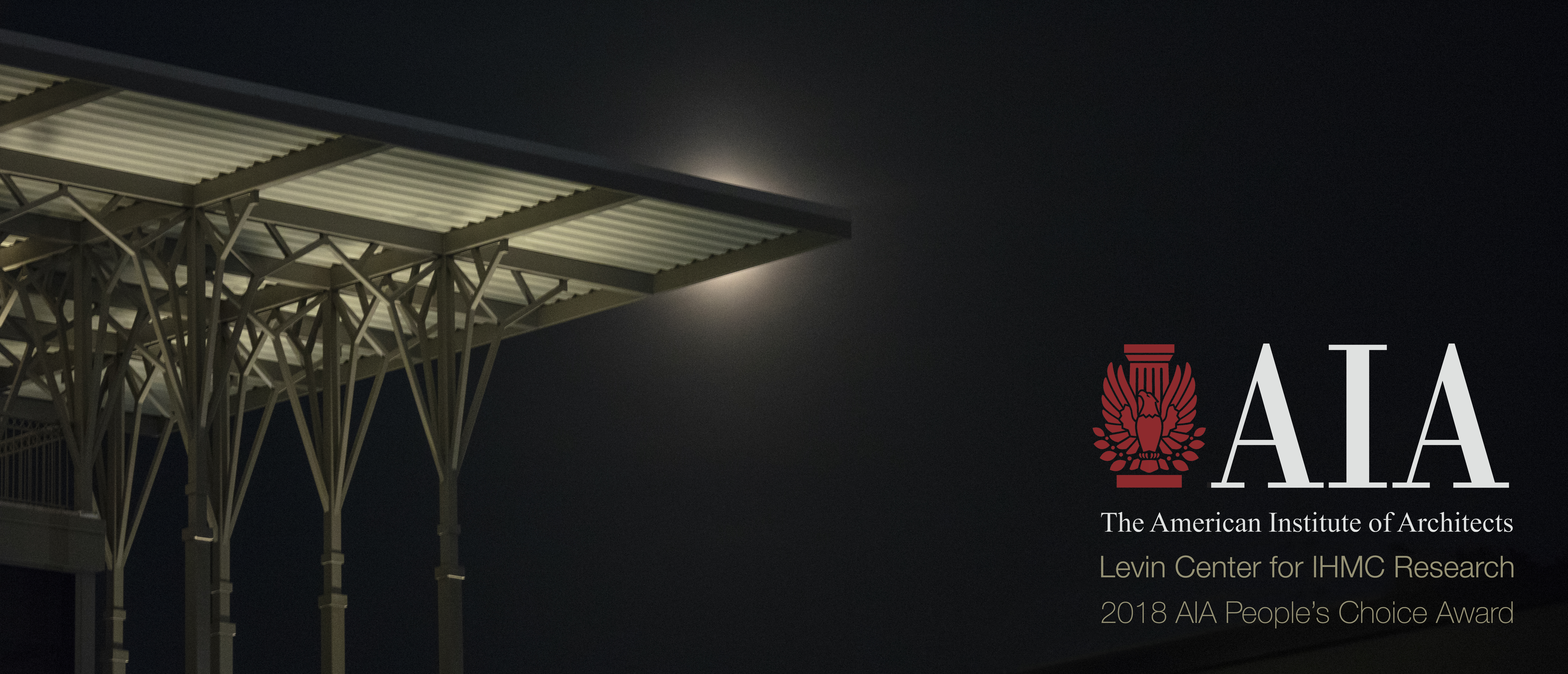
Published 7.30.18
The Florida Association of the American Institute of Architects released the final results of its Florida People’s Choice competition this week and thanks to many of you, the Levin Center for IHMC Research came out on top. For the past several weeks we had sent out requests that asked people to go online and vote for the Levin Center in the AIA competition. We really appreciate that so many people did.
The 30,000-square-foot Levin Center was designed by the Pensacola firm Quina Grundhoefer and was built in 2016. We also owe a big thanks to Pensacola attorney Fred Levin, who donated $1 million to IHMC to help the institute complete the facility.
Carter Quina was the lead architect on the project and had a great quote after he heard the news about the People’s Choice Award. “As architects, we of course like it when our peers evaluate our work and recognize us. But to have your design receive recognition from everyday people is even more special. If people love what we’ve designed, then we’ve done our job. This is really a great honor for us and Pensacola.”
Here is AIA Florid’s press release
Ewers donate $500,000 to IHMC
Published 6.21.18
Ron and Phyllis Ewers have donated $500,000 to the Florida Institute for Human and Machine Cognition, a gift that will allow the research center to make some needed improvements to its glass-enclosed building in downtown Ocala.
IHMC’s Ocala facility was once the home of Marion County’s main branch of its public-library system. Built in the 1960s, the building’s futuristic look became a focal point of Ocala’s downtown. In 2009, the then vacant facility fell into the hands of IHMC, a not-for-profit research institute that is part of the Florida University System with branches in Ocala and Pensacola.
“I was so glad to see IHMC move into the building,” said Ewers, who moved to Ocala in the 1970s and serves on the institute’s board of directors. “The building and the work that goes on at the institute has really become one of Ocala’s jewels.”
One of the distinctive features of the building is the skylight in the center of the roof. But after 60 years, the glass in the skylight has taken on a smoky look.
“Thanks to this gift, we will be able to replace the roof and skylight,” said Laurie Zink, development and community outreach director for the Ocala operation. “We will be able to make other improvements to the building as well. We are so fortunate to have people in our community like Ron and Phyllis.”
Ewers is president of Ewers Consulting in Ocala and has been part owner of a number of companies, including Classic Fire, which is known for its innovations in fire-fighting equipment. Before that, he was president of E-One, one of the world’s largest manufacturers of fire trucks and equipment.
Over the years, Ewers and his wife have also helped fund IHMC’s outreach programs, which range from an evening lecture series to Science Saturdays, a hands-on science program for third-, fourth- and fifth-graders.
“It has just been such a privilege to be on IHMC’s board,” said Ewers. “The institute really has been a great addition to Ocala.”
Studers Donate $1 Million to Further IHMC New Initiatives
Published 4.17.18
Quint and Rishy Studer have generously donated $1 million to the Florida Institute for Human and Machine Cognition. Studer said the gift to IHMC was a natural step for him and his wife, Rishy.
“When I taught special education, the whole goal was to maximize a person’s capabilities. When we formed the Studer Group, it was the same thing…our mission was about maximizing human potential. And that’s what the Studer Community Institute and EntreCon and CivicCon are also about. So, when you look at what IHMC does, it also strives to maximize people’s human potential. That’s why this gift just feels like a natural stair step for Rishy and me.”
IHMC is a not-for-profit research institute that has grown into one of the nation’s premier research organizations with world-class scientists and engineers investigating a broad range of topics related to building technological systems aimed at amplifying and extending human cognition, perception, locomotion and resilience. The institute is part of the Florida University System and is based in Pensacola with a branch in Ocala.
“Quint told us we could use the gift for anything we want, which was great,” said IHMC co-founder and CEO Ken Ford. “But when I brought up the work we’re doing in human performance, which is a relatively new area for us, he seemed to really like the idea of helping us expand our research into this area.”
Much of the IHMC’s work in human performance is focused on humans in extreme environments, such as space, undersea, and high-performance military aircraft. Ford is assembling a cadre of top researchers to employ science and technology to first understand the hazards associated with humans in extreme environments and then to build systems to mitigate those risks.
“The military aircraft is an extreme environment. Astronauts are continuously placed in ridiculously extreme environments. And military divers also face extreme conditions,” said Ford. “Most of the communities we serve are outliers in the human species. These are high-performing humans who are regularly subjected to hazardous environments, and we want to understand the nature of the hazard and how the hazard might be mitigated.”
Studer said he and his wife have long been admirers of Ford and the institute. “I strongly believe you don’t bet on the what…you bet on the who. So, when you look at IHMC over the years, they’ve had solid leadership and world-class scientists. So Rishy and I are investing in the who…the people at IHMC, not the building and not even the science. We’re investing in the who, the people of IHMC.”
Airport display showcases IHMC Research
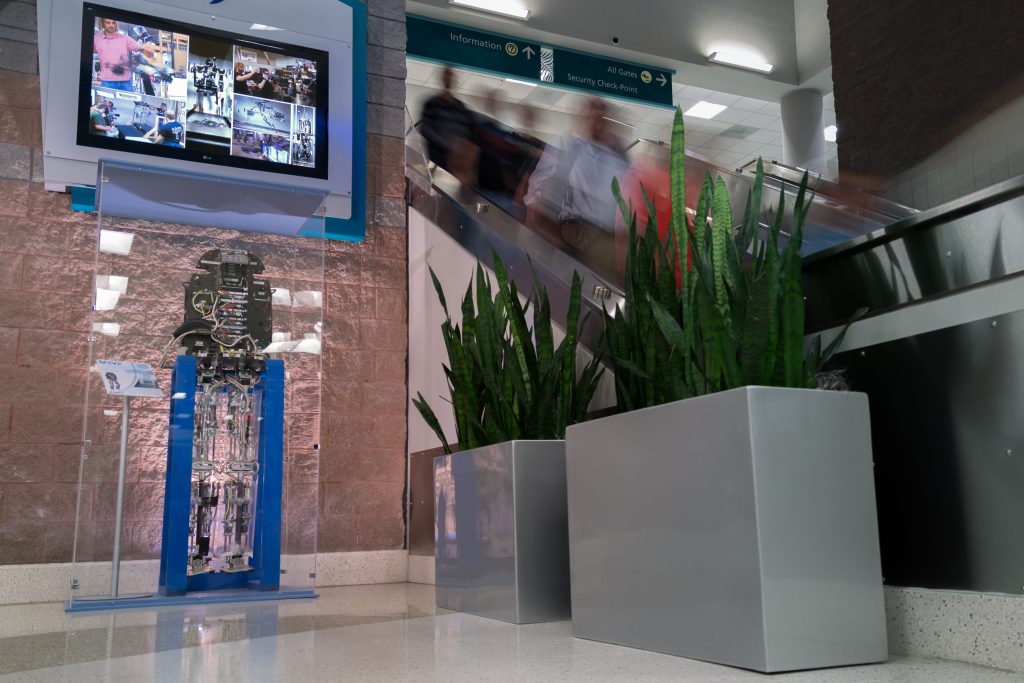
Published 11.2.17
The next time you’re passing through the Pensacola International Airport, be sure to check out the IHMC research display. Several IHMC robots, including the M2V2 humanoid, Spring Flamingo, Mina Exoskeleton, and tBot, will be on display at the airport on a rotating basis.
The display case is located at the main entrance of the airport next to the escalator. There is a monitor above the display case that highlights many areas of IHMC’s research. Brix Design in downtown Pensacola designed and fabricated the acrylic case that houses the robots.
The current robot in the display is M2V2, developed by IHMC in collaboration with the MIT Leg Laboratory, Yobotics, Bucknell University, Delft University of Technology, University of Michigan, and Honda Research Institute. It will be featured until the Spring of 2018.
The next robot on display will be the NASA-IHMC X1 Mina Exoskeleton, a robotic device developed for mobility assistance for abled and disabled users. We also will continue to update the video feed on the monitor to showcase new IHMC research.
Please let us know your thoughts as you view this display and be sure to tell friends to stop by next time they are at the airport.
Dr. Bonnie Dorr Cited for High Honor
 Published 12.5.16
Published 12.5.16
Dr. Bonnie Dorr, associate director and senior research scientist at the Florida Institute for Human & Machine Cognition (IHMC), has been named a fellow of the Association for Computational Linguists (ACL). She is one of four people to be named to this year’s class of ACL fellows. The honor is in recognition of Dorr’s contributions to the field of computational linguistics.
“Bonnie’s work over the years has certainly earned her this well-deserved recognition,” said Ken Ford, the founder and chief executive of IHMC. “She is an exceptional scientist and colleague who has contributed greatly to the advancement of computational linguists.”
In naming Dorr one of its 2016 fellows, ACL specifically highlighted her “significant contributions to machine translation, summarization and human evaluation.” Dorr’s research spans several areas of broad-scale multilingual processing, including machine translation, summarization, and cross-language information retrieval.
Dorr, a professor emeritus of computer science, leads a team of scientists and researchers at IHMC’s Ocala facility. Dorr is the former associate dean of the College of Computer, Mathematical, and Natural Sciences at the University of Maryland. She co-founded the Computational Linguistics and Information Processing Laboratory at Maryland, and served as its co-director for 15 years.
In 2008, she was named president of the ACL. Additionally, she is a Sloan Fellow, an Association for the Advancement of Artificial Intelligence’s (AAAI) Fellow, and a National Science Foundation Presidential Faculty (PECASE) Fellow. Established in 2011, the ACL Fellows program recognizes ACL members whose contributions to the field have been most extraordinary.
The Florida Institute for Human & Machine Cognition (IHMC) is one of the nation’s premier research organizations with world-class scientists and engineers investigating a broad range of topics related to building technological systems aimed at amplifying and extending human cognitive, perceptual, and physical capacities. IHMC headquarters are in Pensacola, Florida, with a branch research facility in Ocala, Florida.
Mission Day 11: Orbicella faveolata, where art thou?
Published 8.5.16
A 4 hour tour…a 4 hour tour.
Once we completed our training Extravehicular Activity (EVA) dives for 1 and 2 hours a piece, it was time to complete a full 4 hour EVA. Megan and I were the first team up on Mission Day 11.
After we suited up, completed safety, staged out from the habitat and weighted ourselves out for partial gravity, we picked up the pre-stages sled packed with presampling tools, including the PAM fluorometer, temporary tags, the iDive iPad for identification and cue cards that the crew can use for information, and a tool kit stuff with smaller EVA tools. One of us is also carrying a Shark Marine navigator to guide us to the target site.
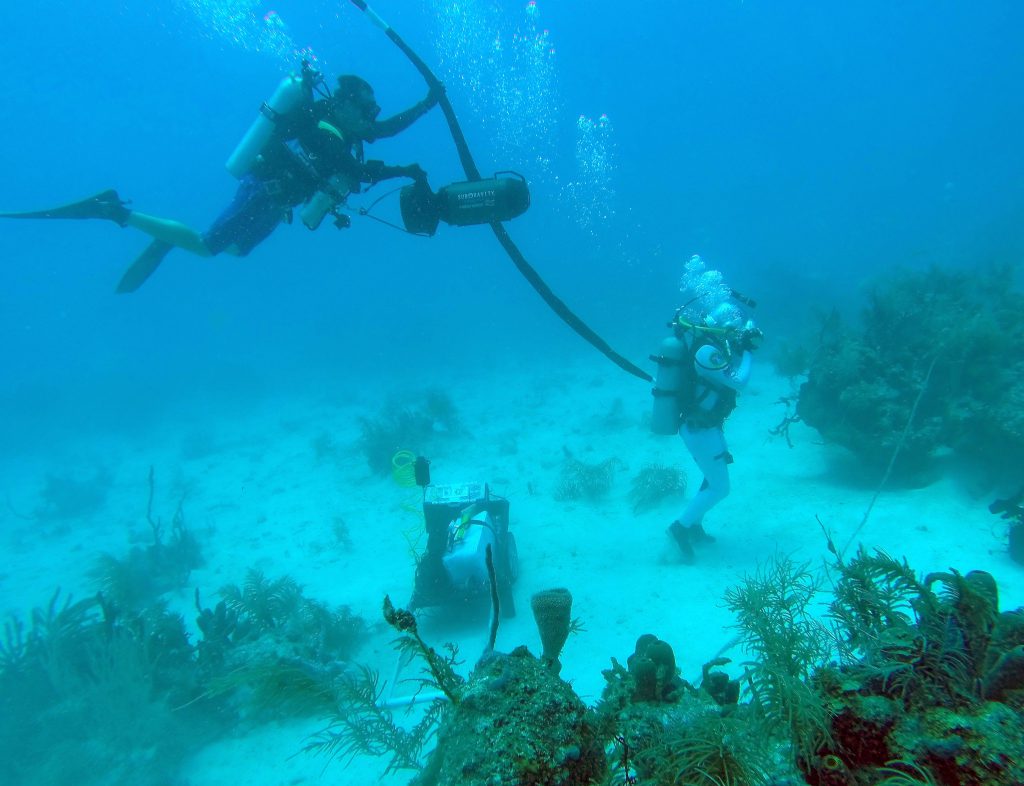
The goal: look for three specific types of coral in one of the ‘deep’ zones, ranging 80-95 FSW in depth. Pulling out sled behind us, we walked down the sandy slopes, past instruments and towering structures left from missions past, turned into artificial reef systems around the habitat. One of the most important things we have to pay attention to on our dives are where our umbilicals are in the water.
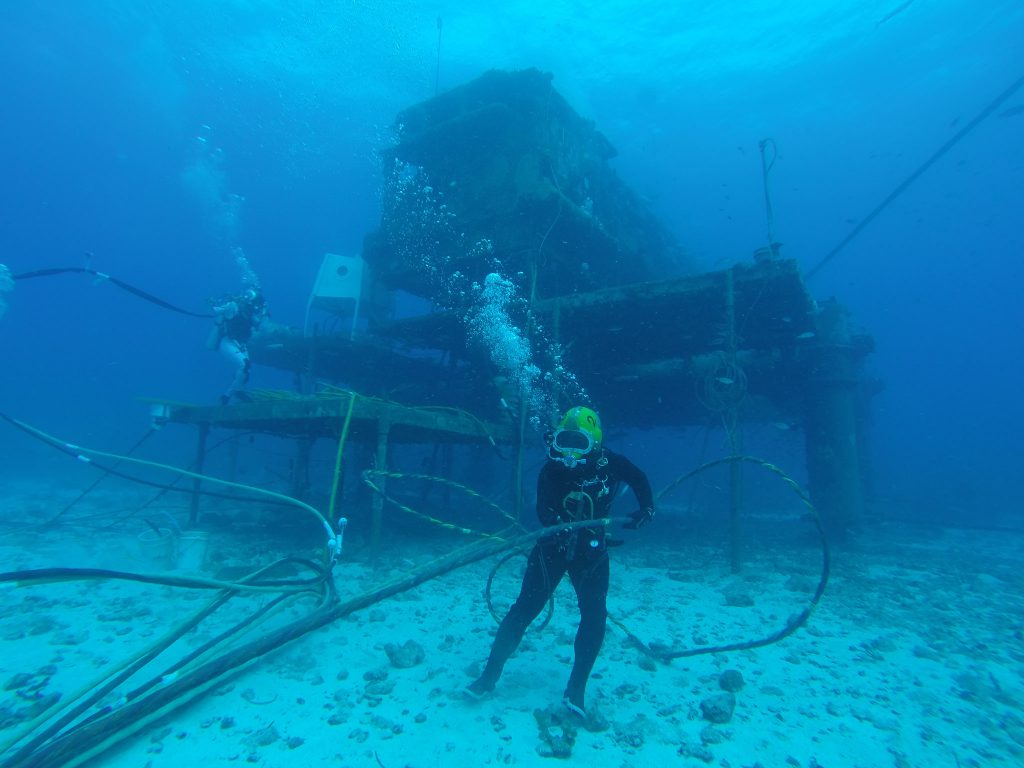
For this mission, we had up to 600 feet of umbilical, which include our air supply, comms, and pneumometer for gauging depth, running back to the habitat that we could work with, which can be an absolute snake best if not properly managed! We had to keep them from wrapping around coral, ourselves, and each other. THANKFULLY, our hard hat safety diver and one of the Aquarius Reef Base habitat technicians, Sean Moore, helped us manage them out to a certain point. After that, we had support divers in the water with Subgravity scooters keeping an eye on where the umbilicals ran as we went deeper. As I mentioned before, it definitely takes an experienced and hard-working village to do these missions safely!
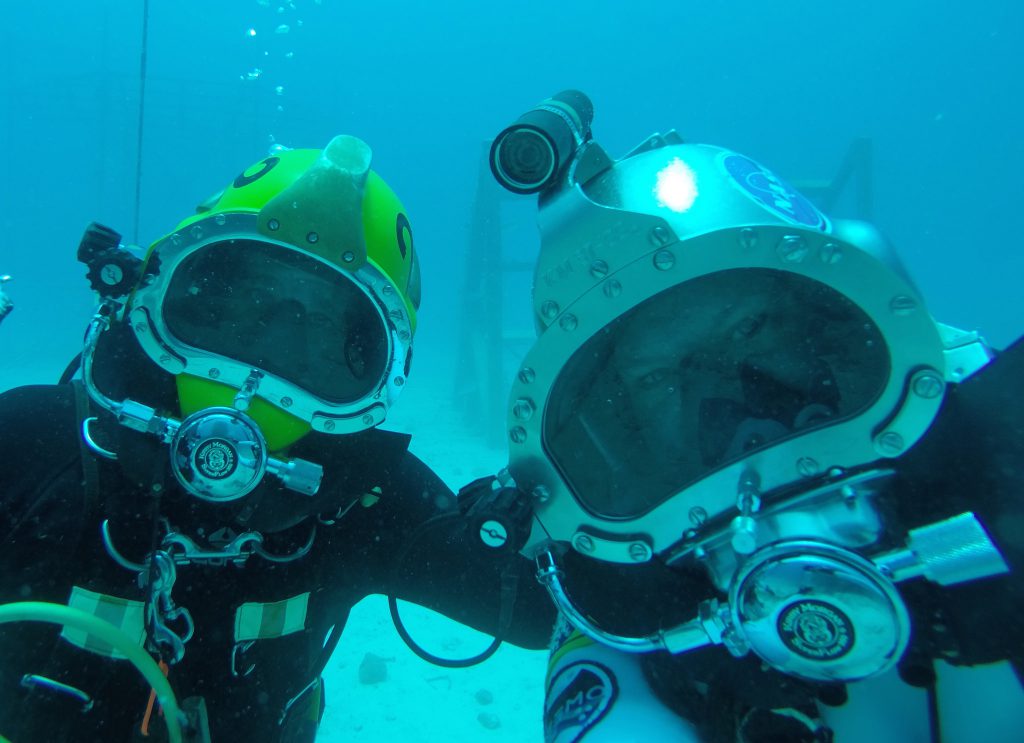
The traverse to the deep reef takes approximately 5 minutes, then we set the sled in a secure location and get to work searching for Orbicella faveolata, Agaricites humilis, and Agaricites agaricia. While some coral species were very easy to locate, others are not as prevalent in certain designated zones or depth ranges. We searched until we ran out of temporary tags, identifying 22 species for potential sampling! For each tagged coral, we then take photos and PAM readings for the science team to review. We read all of this information back to IV (the person running the show from inside the habitat), which is then relayed back to the science team via time-delayed messages and a data sheet. They will give feedback for our next EVA in which of the species they want us to sample. Ultimately, these procedures are all being evaluated as NASA moves towards planetary exploration missions, where boots on the ground will need to be able to relay science and exploration back to the appropriate support teams and Mission Control for decision making and data management.
When we wrapped up the presampling phase, we picked up the sled and walked back up the sandy slope towards the habitat, cutting left to the Mercury coral tree nursery that was built in collaboration with the Coral Restoration Foundation during the first half of the mission. We collected PAM readings from the samples there before heading back to the habitat, with the IV and Science Team calling it a successful day!
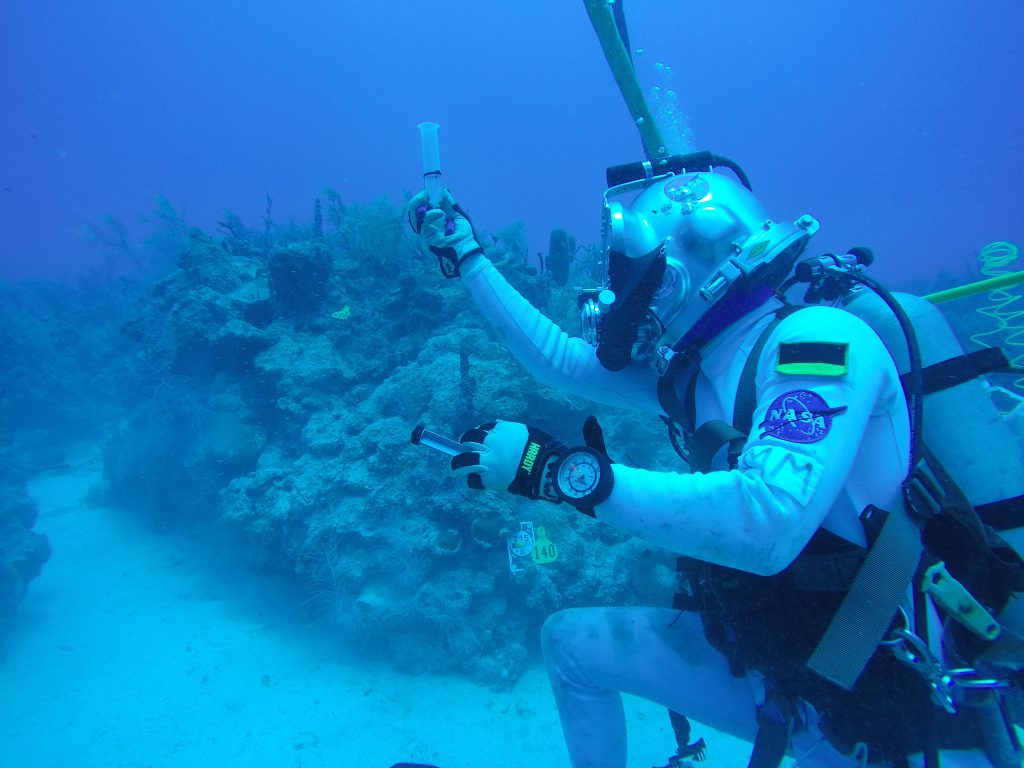
Compared to regular SCUBA, the hard hat system is amazing because of the real-time comms and continuous gas supply. The partial gravity weighting, plus the weight of the helmet, require strength and stamina throughout the dive – by the end of the executions, we can all definitely feel the physical and mental fatigue setting in – and a craving for pizza starts to kick in, too! IV is continuously asking us to rate our discomfort and perceived exertion (on a predefined scale) for feedback to Mission Control and as part of a study being conducted by NASA.
On Mission Day 12, I get to run IV communication – a little nervous while very excited to give it a go! Details to follow in be MD 12 blog!
IHMC Robotics team heads to historic competition
Published 9.10.15
The robotics team from the Florida Institute for Human and Machine Cognition (IHMC) leaves this weekend for what promises to be a historic milestone in the science of making machines move and think like humans.
The DARPA Robotics Challenge Finals, to be held June 5-6 in Pomona, Calif., is sponsored by the Defense Advanced Research Projects Agency. It will test 25 teams from around the world in a challenge course designed to emulate a disaster area where humans could not safely go. IHMC’s team will be using the 6-foot-tall Atlas robot, built by Boston Dynamics but with the all-important controlling software designed by IHMC researchers.
The winning team will bring home $2 million from DARPA, which will go to further robotics research. The second-place team will win $1 million.
“It’s been a lot of non-stop work, but we’re ready to go,” said Doug Stephen, one of the computer scientists on the project for IHMC.
For years, movies and television shows have portrayed bipedal robots as virtually flawless, fast-moving, self-thinking units. But the reality has lagged far behind that characterization. The DARPA Robotics Challenge was designed to push the science and engineering to the next level. And in recent weeks, IHMC’s Atlas, nicknamed “Running Man,” has stepped up to the occasion, performing well on the tasks it will face in the finals, including driving a car, walking over a debris field, opening doors, cutting a hole in a wall, turning a valve for a fire hose and climbing stairs.
The finals require the robots to think for themselves to a large degree and perform the eight tasks in 60 minutes or less — on battery power, without a safety line, and with limited communications with their handlers. This week, IHMC’s machine finished the practice course well within the time frame.
“I am unconditionally proud of our robotics team and hope that the robot fates smile upon them in Pomona,” said IHMC CEO/Director Ken Ford. “They are a terrific group of young engineers and computer scientists.”
In the first two rounds of the Robotics Challenge in 2013, IHMC placed first in the virtual (computer simulation) trials, and second in the field trials, thanks in large part to the advanced computer software IHMC developed, organizers said. Other teams in next week’s finals come from some of the most advanced robotics programs in the country, including Massachusetts Institute of Technology, Lockheed Martin, and Carnegie Mellon University, as well as several teams from Japan, South Korea, China and Germany.
IHMC robotics staff members are planning to spend most of Thursday and Friday packing Atlas, the Polaris four-wheeled vehicle it will drive, and almost a ton of support and computer equipment for shipment by FedEx to California. The truck and most team members leave Saturday morning.
A video of Wednesday’s final practice run at the IHMC Robotics Lab in Pensacola can be seen here:https://www.youtube.com/watch?v=iCPiNOwh2is. Photos of the Atlas robot and the research team are attached to this email. IHMC also hopes to provide a news release Saturday night, June 6, after the results of the finals are announced.
For more information, contact Will Rabb, IHMC communications coordinator, at 850-512-4327 or email atwrabb@ihmc.us. DARPA updates on the competition can be found at http://www.theroboticschallenge.org.
NASA Asteroid Redirect Mission App
Published 9.10.15
NASA’s Asteroid Redirect Mission iPad App has been released and is available for free download at the iTunes Store. The creation of this novel App was a joint effort between NASA and IHMC. The App is a large knowledge model that uses dozens of concept maps to organize and navigate through hundreds of videos, images and Web links on NASA’s Asteroid Redirect Mission. Each of the concept maps represents the knowledge of experts on the particular topic.
All concept maps in this app were constructed using the IHMC CmapTools software which is available free for download.
Check our web page, download and experience the App, and then go give us a great review. 5 star reviews are warranted and appreciated!
http://cmap.ihmc.us/armapp/
IHMC Moves Ahead with Pensacola Expansion
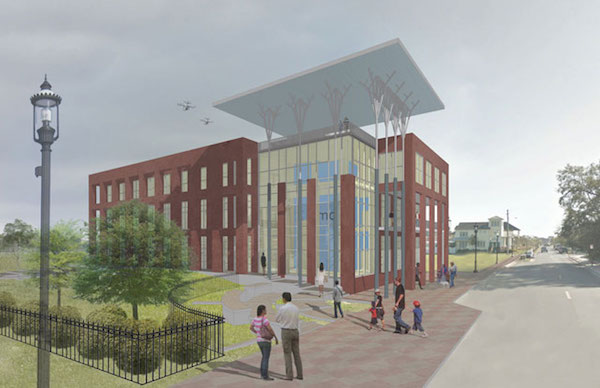
Published 9.4.15
The Florida Institute for Human and Machine Cognition is back on track with a planned expansion of its Pensacola research facility following a nearly year-long delay caused by flooding of downtown in April 2014.
Completion is scheduled for February 2016. The contractor is Hewes and Company LLC, a Pensacola firm. Hewes has done extensive work across the Pensacola area, including large buildings for Pensacola Christian College, Avalex Technologies and AppRiver.
“We’re really pleased to be back on track with the new building,” said IHMC Director and CEO Ken Ford. “The delay was troublesome, but the architects were able to develop some really good, workable solutions. We’re eager now to get this building built and keep growing in Pensacola.”
In response to the flooding, the first floor of the new building was redesigned to raise it by one foot, to an elevation of 13 feet above sea level, and all structural materials were reviewed to ensure that they are water-resistant. Meanwhile, flood damage to the existing building has been repaired, but a planned expansion of that facility remains on hold.
The three-story, 30,000-square-foot building will substantially increase IHMC’s Pensacola footprint, allowing consolidation of research and administrative functions at the main campus at 40 S. Alcaniz Street in the Seville Historic District, and allow for future growth. IHMC’s operations are currently spread over four separate sites in downtown.
The $8 million expansion is being funded with a loan secured through Escambia County. IHMC is solely responsible for repayment of the loan.
The new building will face Romana Street and be located behind the current facility on land IHMC owns between Alcaniz and Florida Blanca streets. The building’s facade will be reminiscent of the old brick warehouses that used to dominate the area while serving the Port of Pensacola.
Lead architect Carter Quina, AIA, of Quina Grundhoefer Architects in Pensacola, said the appearance of the redesigned building remains virtually the same as before, while providing more security against potential future flooding. It retains its “fit” with the nearby historic neighborhoods.
“We worked hard to give it a look that fits in with the Historic District, and that remains,” Quina said. “The interior is high-tech, but the exterior reflects its location in what the city designated as the Brick Warehouse District, and the use of brick, steel and concrete, all historical materials used in the area, gives it that feel. We’re also adding glass to allow natural daylight inside and to make the interior accessible to the public.”
He said the new building features design and technology that “maintain all of our sustainability goals,” including the extensive use of natural daylight, LED lighting that adjusts to the daylight, extensive soundproofing for the labs, durable materials, and a powerful lab hoist designed with input from the scientists who will be using it.
The building was also designed to foster the use of stairs instead of elevators, cutting energy use and helping employees stay fit.
The first floor of the new building will largely consist of research labs, including an expanded Robotics Lab and a multi-sensory interfaces lab focused on sensory displays and human-machine interfaces, and a street-front lobby/exhibit space demonstrating the work at IHMC.
The second floor will feature a glass-walled observation area for public tour groups and others to observe the Robotics Lab safely and without interfering with the work. The lab is a popular tour destination for schools and other visitors.
The third floor will hold additional offices, conference rooms and research space.
